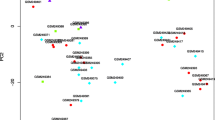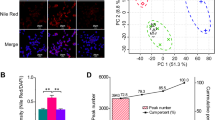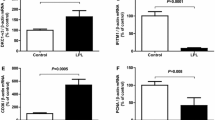Abstract
Atherosclerotic morbidity is significantly higher in the diabetic population. Hyperglycemia, a typical feature of diabetes, has been proven to accelerate foam cell formation. However, the molecular mechanisms behind this process remain unclear. In this study, LPS and IFN-γ were used to convert THP-1-derived macrophages into M1 macrophages, which were then activated with ox-LDL in either high glucose or normal condition. We identified lipids within macrophages by Oil red O staining and total cholesterol detection. The genes involved in lipid absorption, efflux, inflammation, and metabolism were analyzed using qRT-PCR. The mechanisms of high glucose-induced foam cell formation were further investigated through metabolomics and transcriptomics analysis. We discovered that high glucose speed up lipid accumulation in macrophages (both lipid droplets and total cholesterol increased), diminished lipid efflux (ABCG1 down-regulation), and aggravated inflammation (IL1B and TNF up-regulation). Following multi-omics analysis, it was determined that glucose altered the metabolic and transcriptional profiles of macrophages, identifying 392 differently expressed metabolites and 293 differentially expressed genes, respectively. Joint pathway analysis suggested that glucose predominantly disrupted the glycerolipid, glycerophospholipid, and arachidonic acid metabolic pathways in macrophages. High glucose in the glyceride metabolic pathway, for instance, suppressed the transcription of triglyceride hydrolase (LIPG and LPL), causing cells to deposit excess triglycerides into lipid droplets and encouraging foam cell formation. More importantly, high glucose triggered the accumulation of pro-atherosclerotic lipids (7-ketocholesterol, lysophosphatidylcholine, and glycerophosphatidylcholine). In conclusion, this work elucidated mechanisms of glucose-induced foam cell formation via a multi-omics approach.






Similar content being viewed by others
Data availability
All data generated or analyzed during this study are included in this published article and its supplementary information files. Further any enquiries can be directed to the corresponding author.
Abbreviations
- 7-KC:
-
7-Ketocholesterol
- AS:
-
Atherosclerosis
- CE:
-
Cholesteryl esters
- Control:
-
Blank control group
- DEGs:
-
Differentially expressed genes
- DEMs:
-
Differentially expressed metabolites
- FC:
-
Fold change
- GPC:
-
Glycerophosphocholine
- IFN-γ:
-
Interferon γ
- KEGG:
-
Kyoto Encyclopedia of Genes and Genomes
- KOBAS:
-
KEGG Orthology-based Annotation System
- LPS:
-
Lipopolysaccharide
- LysoPC:
-
Lysophosphatidylcholine.
- OPLS-DA:
-
Orthogonal projections to latent structures-discriminant analysis
- ORO:
-
Oil red O
- Ox-LDL:
-
Oxidized low-density lipoprotein
- oxLDL:
-
oxLDL-induced group
- oxLDL + HG:
-
oxLDL plus high glucose-induced group
- PC:
-
Phosphatidylcholine
- PCA:
-
Principal component analysis
- PGH2:
-
Prostaglandin H2
- PMA:
-
Phorbol myristic acid
- qRT-PCR:
-
Quantitative real-time PCR
- RNA-seq:
-
RNA sequencing
- TG:
-
Triglycerides
- VIP:
-
Variable importance for the projection
References
Bjorkegren JLM, Lusis AJ (2022) Atherosclerosis: recent developments. Cell 185:1630–1645
Kobiyama K, Ley K (2018) Atherosclerosis. Circ Res 123:1118–1120
Herrington W, Lacey B, Sherliker P, Armitage J, Lewington S (2016) Epidemiology of atherosclerosis and the potential to reduce the global burden of atherothrombotic disease. Circ Res 118:535–546
Gistera A, Ketelhuth DFJ (2018) Lipid-driven immunometabolic responses in atherosclerosis. Curr Opin Lipidol 29:375–380
Back M, Yurdagul A Jr, Tabas I, Oorni K, Kovanen PT (2019) Inflammation and its resolution in atherosclerosis: mediators and therapeutic opportunities. Nat Rev Cardiol 16:389–406
Ammanamanchi M, Maurer M, Hayenga HN (2021) Inflammation drives stiffness mediated uptake of lipoproteins in primary human macrophages and foam cell proliferation. Ann Biomed Eng 49:3425–3437
Maguire EM, Pearce SWA, Xiao Q (2019) Foam cell formation: a new target for fighting atherosclerosis and cardiovascular disease. Vascul Pharmacol 112:54–71
Zhao Y, Jia X, Yang X, Bai X, Lu Y, Zhu L, Cheng W, Shu M, Zhu Y, Du X, Wang L, Shu Y, Song Y, Jin S (2022) Deacetylation of caveolin-1 by sirt6 induces autophagy and retards high glucose-stimulated ldl transcytosis and atherosclerosis formation. Metabolism 131:155162
Leon BM, Maddox TM (2015) Diabetes and cardiovascular disease: Epidemiology, biological mechanisms, treatment recommendations and future research. World J Diabetes 6:1246–1258
Torres-Castro I, Arroyo-Camarena ÚD, Martínez-Reyes CP, Gómez-Arauz AY, Dueñas-Andrade Y, Hernández-Ruiz J, Béjar YL, Zaga-Clavellina V, Morales-Montor J, Terrazas LI, Kzhyshkowska J, Escobedo G (2016) Human monocytes and macrophages undergo m1-type inflammatory polarization in response to high levels of glucose. Immunol Lett 176:81–89
Poznyak A, Grechko AV, Poggio P, Myasoedova VA, Alfieri V, Orekhov AN (2020) The diabetes mellitus-atherosclerosis connection: the role of lipid and glucose metabolism and chronic inflammation. Int J Mol Sci. https://doi.org/10.3390/ijms21051835
Chung J, An SH, Kang SW, Kwon K (2016) Ursodeoxycholic acid (udca) exerts anti-atherogenic effects by inhibiting rage signaling in diabetic atherosclerosis. PLoS One 11:e0147839
Ramachandran S, Vinitha A, Kartha CC (2016) Cyclophilin a enhances macrophage differentiation and lipid uptake in high glucose conditions: a cellular mechanism for accelerated macro vascular disease in diabetes mellitus. Cardiovasc Diabetol 15:152
Bouchareychas L, Duong P, Phu TA, Alsop E, Meechoovet B, Reiman R, Ng M, Yamamoto R, Nakauchi H, Gasper WJ, Van Keuren-Jensen K, Raffai RL (2021) High glucose macrophage exosomes enhance atherosclerosis by driving cellular proliferation & hematopoiesis. iScience 24:102847
Karczewski KJ, Snyder MP (2018) Integrative omics for health and disease. Nat Rev Genet 19:299–310
Ji L, Chen S, Gu G, Wang W, Ren J, Xu F, Li F, Wu J, Yang D, Zheng Y (2021) Discovery of potential biomarkers for human atherosclerotic abdominal aortic aneurysm through untargeted metabolomics and transcriptomics. J Zhejiang Univ Sci B 22:733–745
Zhou Y, Zhang T, Wang X, Wei X, Chen Y, Guo L, Zhang J, Wang C (2015) Curcumin modulates macrophage polarization through the inhibition of the toll-like receptor 4 expression and its signaling pathways. Cell physiol biochem 36:631–641
Geng P, Zhu H, Zhou W, Su C, Chen M, Huang C, Xia C, Huang H, Cao Y, Shi X (2020) Baicalin inhibits influenza a virus infection via promotion of m1 macrophage polarization. Front Pharmacol 11:01298
Sini S, Deepa D, Harikrishnan S, Jayakumari N (2017) High-density lipoprotein from subjects with coronary artery disease promotes macrophage foam cell formation: role of scavenger receptor cd36 and erk/mapk signaling. Mol Cell Biochem 427:23–34
Ye G, Gao H, Wang Z, Lin Y, Liao X, Zhang H, Chi Y, Zhu H, Dong S (2019) Pparα and pparγ activation attenuates total free fatty acid and triglyceride accumulation in macrophages via the inhibition of fatp1 expression. Cell Death Dis 10:39
Sun H, Wang B, Wang J, Liu H, Liu J (2016) Biomarker and pathway analyses of urine metabolomics in dairy cows when corn stover replaces alfalfa hay. J Anim Sci Biotechnol 7:49
Li W, Kuang Z, Zheng M, He G, Liu Y (2020) Multi-omics integrative analysis to access role of coiled-coil domain-containing 80 in lipid metabolism. Biochem Biophys Res Commun 526:813–819
Otsuka F, Kramer MCA, Woudstra P, Yahagi K, Ladich E, Finn AV, de Winter RJ, Kolodgie FD, Wight TN, Davis HR, Joner M, Virmani R (2015) Natural progression of atherosclerosis from pathologic intimal thickening to late fibroatheroma in human coronary arteries: a pathology study. Atherosclerosis 241:772–782
Ramachandran S, Venugopal A, Sathisha K, Reshmi G, Charles S, Divya G, Chandran NSP, Mullassari A, Pillai MR, Kartha CC (2012) Proteomic profiling of high glucose primed monocytes identifies cyclophilin a as a potential secretory marker of inflammation in type 2 diabetes. Proteomics 12:2808–2821
Puig N, Montolio L, Camps-Renom P, Navarra L, Jiménez-Altayó F, Jiménez-Xarrié E, Sánchez-Quesada JL, Benitez S (2020) Electronegative ldl promotes inflammation and triglyceride accumulation in macrophages. Cells. https://doi.org/10.3390/cells9030583
Walther TC, Chung J, Farese RV (2017) Lipid droplet biogenesis. Annu Rev Cell Dev Biol 33:491–510
Zani IA, Stephen SL, Mughal NA, Russell D, Homer-Vanniasinkam S, Wheatcroft SB, Ponnambalam S (2015) Scavenger receptor structure and function in health and disease. Cells 4:178–201
Song Z, Lv S, Wu H, Qin L, Cao H, Zhang B, Ren S (2020) Identification of foam cell biomarkers by microarray analysis. BMC Cardiovasc Disord 20:211
Qin X, Qiu C, Zhao L (2014) Lysophosphatidylcholine perpetuates macrophage polarization toward classically activated phenotype in inflammation. Cell Immunol 289:185–190
Chang M-C, Lee J-J, Chen Y-J, Lin S-I, Lin L-D, Jein-Wen Liou E, Huang W-L, Chan C-P, Huang C-C, Jeng J-H (2017) Lysophosphatidylcholine induces cytotoxicity/apoptosis and il-8 production of human endothelial cells: related mechanisms. Oncotarget 8:106177–106189
Zhao Y, Wang Z (2020) Impact of trimethylamine N-oxide TMAO metaorganismal pathway on cardiovascular disease. J Lab Precis Med. https://doi.org/10.21037/jlpm.2020.01.01
Seldin MM, Meng Y, Qi H, Zhu W, Wang Z, Hazen SL, Lusis AJ, Shih DM (2016) Trimethylamine n-oxide promotes vascular inflammation through signaling of mitogen-activated protein kinase and nuclear factor-κb. J Am Heart Assoc. https://doi.org/10.1161/JAHA.115.002767
Song J, Wang D, Chen H, Huang X, Zhong Y, Jiang N, Chen C, Xia M (2017) Association of plasma 7-ketocholesterol with cardiovascular outcomes and total mortality in patients with coronary artery disease. Circ Res 120:1622–1631
Ravi S, Duraisamy P, Krishnan M, Martin LC, Manikandan B, Raman T, Sundaram J, Arumugam M, Ramar M (2021) An insight on 7- ketocholesterol mediated inflammation in atherosclerosis and potential therapeutics. Steroids 172:108854
Nury T, Zarrouk A, Yammine A, Mackrill JJ, Vejux A, Lizard G (2021) Oxiapoptophagy: a type of cell death induced by some oxysterols. Br J Pharmacol 178:3115–3123
Rosa-Fernandes L, Maselli LMF, Maeda NY, Palmisano G, Bydlowski SP (2017) Outside-in, inside-out: proteomic analysis of endothelial stress mediated by 7-ketocholesterol. Chem Phys Lipids 207:231–238
Angsana J, Chen J, Smith S, Xiao J, Wen J, Liu L, Haller CA, Chaikof EL (2015) Syndecan-1 modulates the motility and resolution responses of macrophages. Arterioscler Thromb Vasc Biol 35:332–340
Hartmann P, Schober A, Weber C (2015) Chemokines and micrornas in atherosclerosis. Cell Mol Life Sci 72:3253–3266
Ryu J-H, Ge M, Merscher S, Rosenberg AZ, Desante M, Roshanravan H, Okamoto K, Shin MK, Hoek M, Fornoni A, Kopp JB (2019) Apol1 renal risk variants promote cholesterol accumulation in tissues and cultured macrophages from apol1 transgenic mice. PLoS One 14:e0211559–e0211559
Acknowledgements
Thanks to the members of our laboratory for their contributions.
Funding
This work was supported by the Natural Science Basic Research Program of Shaanxi province (Grant No. 2019JM-440), and The Science and Technology Project of Shaanxi Province (Grant No. 2014K11-03-01-07, 2022SF-152).
Author information
Authors and Affiliations
Contributions
JQ, YL and CS contributed to the conception and design of the study. JQ, YL, NZ and WH performed the experiments and performed statistical analysis. JQ and QG analyzed transcriptome and metabolome data. JQ wrote the manuscript. All authors have reviewed and edited the article. JQ and CS provided funding acquisition and supervision. All authors contributed to the article and approved the submitted version.
Corresponding author
Ethics declarations
Competing interest
The authors declare no potential conflict of interest.
Additional information
Publisher's Note
Springer Nature remains neutral with regard to jurisdictional claims in published maps and institutional affiliations.
Supplementary Information
Below is the link to the electronic supplementary material.
Rights and permissions
Springer Nature or its licensor holds exclusive rights to this article under a publishing agreement with the author(s) or other rightsholder(s); author self-archiving of the accepted manuscript version of this article is solely governed by the terms of such publishing agreement and applicable law.
About this article
Cite this article
Qi, J., Lv, Y., Zhong, NE. et al. Multi-omics analysis identifies potential mechanisms by which high glucose accelerates macrophage foaming. Mol Cell Biochem 478, 665–678 (2023). https://doi.org/10.1007/s11010-022-04542-w
Received:
Accepted:
Published:
Issue Date:
DOI: https://doi.org/10.1007/s11010-022-04542-w




